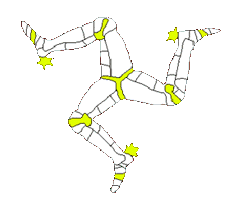Rotational Symmetry
A shape is said to have Rotational Symmetry when it can be turned or twisted around a point and make exactly the same shape. The number of times that the same shape can be made throughout a complete revolution is known as the 'order of rotational symmetry'. The point that the shape revolves around is known as the 'centre of rotation', there is only one centre of rotation possible within the shape.
If a shape does not have any rotational symmetry it is said to have an order of rotational symmetry of 1, because there is only one position that the shape looks the same.
Another way to think of this is by seeing how many times a shape will exactly cover the original shape when it is turned through 360° |
Look at this Mercedes Benz emblem - If it was rotated a third of a full turn (120°) it would look the same.
If it was rotated a further 120° it would look the same again.
There are three positions in one complete revolution where the shape looks the same.
So it has an order of rotation of 3.
|
|
A good way of checking for rotational symmetry is to use tracing paper to copy the outline of the shape and then turn the tracing paper over the original and count how many times the shapes match. (Tip: make a mark on the tracing paper on one of the points of the shape so that you can see how far you have rotated the shape).
Examples of rotational symmetry. |
|
There is only one position that the shape looks the same.
It has no rotational symmetry - order of rotational symmetry = 1 |
|
There are two positions that the shape looks the same.
Order of rotational symmetry = 2 |
|
There are three positions that the shape looks the same.
Order of rotational symmetry = 3 |
|
There are four positions that the shape looks the same.
Order of rotational symmetry = 4 |
|
There are five positions that the shape looks the same.
Order of rotational symmetry = 5 |
Quite often you will be asked to find the order of symmetry of letters of the alphabet, so investigate these with your child.
Also regular polygons - work through these, squares, pentagons, hexagons etc - you will find that the order of rotational symmetry for regular polygons is equal to the number of sides (also the number of lines of symmetry equals the number of sides)
Look at these shapes from the real world and work out their order of rotational symmetry.
   
|
|
|
|
